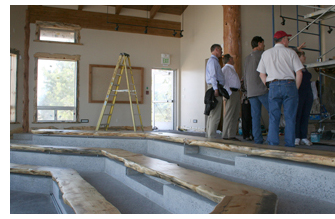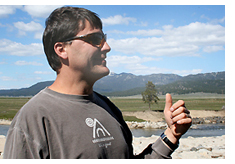
| CONNECTIONS |
IDAHO
ITD
HOME
511 TRAVEL SERVICES
IDAHO
DMV
ITD
NEWS
HIGHWAY
SAFETY
IDAHO STATE POLICE
STATE OF IDAHO
NIATT
NATIONAL
AASHTO
AAMVA
AAA of IDAHO
FEDERAL HIGHWAYS
FEDERAL AVIATION
IDAHO STATE POLICE
NHTSA
NTSB
TRB
U.S. DOT
TRANSPORTER
Archives
Milestones
Comments
Idaho
Transportation
Department
Office of Communications
P.O. Box 7129
Boise, ID 83707
208.334.8005
Fax: 208.334.8563

Community input instrumental in planning
future transportation development
ITD concludes phase of statewide meetings on mobility, safety and economy 'We’re seeing river recreationists and spectators parking along the river. If tourism is one of our primary drivers, we should facilitate that a little better by creating parking places along key points of the river.' — Delta James, Sage Community Resources |

The first set of statewide meetings on improving safety, increasing mobility and growing Idaho’s economy concluded this month with a round-table discussion in Cascade.
ITD's Transportation Planning Division staff members toured the state in April and May to meet with chambers of commerce, city planners, city engineers, legislators, metropolitan planning organizations, business owners, Native American tribes and others to gather input on how ITD’s highway system can benefit communities.
At the round-table discussion in Cascade, a business owner and planning specialist said highways and local roads need to take into account the area’s outdoor-based tourism and timber industry.
“We’re seeing river recreationists and spectators parking along the river,” said Delta James, a planning specialist with Sage Community Resources. James was referring to kayakers and rafters on the Payette River, and motorists who pull off of Idaho 55 to watch them navigate rapids. “If tourism is one of our primary drivers, we should facilitate that a little better by creating parking places along key points of the river.”
 The Cascade meeting, as well as the others throughout the state, included a discussion on the area’s economic drivers, the businesses or industries that generate significant employment and profits.
The Cascade meeting, as well as the others throughout the state, included a discussion on the area’s economic drivers, the businesses or industries that generate significant employment and profits.
Katrin Thompson, co-owner of the Ashley Inn in Cascade, said changes in the timber industry could mean a shift to new businesses, and tourism becoming an economic driver.
“With the ending of the Boise Cascade mill, it could be that Cascade will develop into a tourism/recreation town,” Thompson said. “People want to come up and recreate in this area. It’s a beautiful area.”
Thompson and her husband, Ashley, built the 67-room Ashley Inn and an R-V park just off of Idaho 55, close to Cascade’s downtown. Katrin Thompson said the town has potential to develop niche tourist attractions.
“Cascade would like to be one of the number one spots for RVers in the state of Idaho,” she said, adding that routes into Cascade need to be navigable and have as few potholes as possible. “Otherwise, their stuff is everywhere after it falls off an RV when it hits a pothole.”
James, of Sage Community Resources, said that despite declines in local timber harvests, the industry shouldn’t be disregarded.
“I think in the future, forest products are going to be important again,” she said, mentioning woody biomass as an example. It’s trees, plants, limbs, tree tops, needles and leaves that are used for bio-energy, paper, pulp, furniture and other products. James said local highway routes will be needed to get the biomass from remote sites. “Part of the challenge is trucking it to where it can be utilized.”
The Cascade meeting included a tour of Kelly’s Whitewater Park, now under construction on the east side of Idaho 55. The park’s creation started with Mark and Kristina Pickard, a Miami Beach couple that has a vacation home in Donnelly. The park is named in honor of Kristina’s late sister, Kelly Brennan.
 Cameron Cordova, a general contractor and project manager for the park’s construction, said it will allow kayakers to test their skills in a stretch of the North Fork of the Payette River. The park consists of a man-made island in the middle of the river, rapids, an outdoor amphitheater looking downriver, an indoor lodge-style center with restrooms, changing rooms, a fireplace and indoor seating for up to 133 people. Two interactive Web cams will be mounted outside to allow people to pan up and down the park to watch kayakers and rafters. During competitions, the Web cams will be stationary to allow those inside the center to watch competitions on two 52-inch monitors. Two other monitors will show programs on the people who are part of Long Valley’s history.
Cameron Cordova, a general contractor and project manager for the park’s construction, said it will allow kayakers to test their skills in a stretch of the North Fork of the Payette River. The park consists of a man-made island in the middle of the river, rapids, an outdoor amphitheater looking downriver, an indoor lodge-style center with restrooms, changing rooms, a fireplace and indoor seating for up to 133 people. Two interactive Web cams will be mounted outside to allow people to pan up and down the park to watch kayakers and rafters. During competitions, the Web cams will be stationary to allow those inside the center to watch competitions on two 52-inch monitors. Two other monitors will show programs on the people who are part of Long Valley’s history.
If other whitewater parks are any indication, Kelly’s Whitewater Park could become an economic driver for Cascade. Cordova said a whitewater park in Nevada draws tens of thousands of people. The annual Reno River Festival attracts between 40,000 and 45,000 people.
Kelly’s Whitewater Park is scheduled to open this summer.
Comments gathered at the Cascade meeting and other meetings will be used in the transportation department’s Statewide Transportation Plan. The plan will create strategies to grow the state’s economy, improve safety and increase mobility. The economic component of the plan will support Gov. C.L. "Butch" Otter’s Project 60, which is an effort to increase Idaho’s gross domestic product from $51.5 billion to $60 billion during the next 10 to 20 years. Project 60 also is designed to create economic opportunities in rural communities as well as urban areas.
Photos: (Top) The visitor’s center for Kelly’s Whitewater Park overlooks the North Fork of the Payette River in Cascade.
The park, scheduled to open this summer, will offer free kayaking lessons and host competitions. Organizers
of the park hope it will bring tourists to Cascade and strengthen the local economy. (Middle) ITD and Department of Commerce staff tour the inside
of the visitor’s center for Kelly’s Whitewater Park in Cascade. The visitor’s center overlooks
a section of the North Fork of the Payette River where kayak competitions will be held. (Bottom) Construction manager Cameron Cordova explains plans for Kelly’s Whitewater Park in Cascade.
Published 5-28-2010